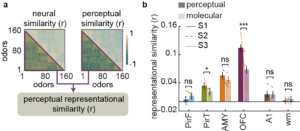 Hot Off the Press – September 2023
Hot Off the Press – September 2023
Published in Nature Neuroscience by Thorsten Kahnt, et al.
Summary
Odorous molecules evoke distributed patterns of activity in olfactory cortices but how these patterns map onto inherently subjective odor percepts has remained unclear. In this study, Sagar and colleagues addressed this question by collecting high-resolution neural and perceptual responses to one hundred and sixty monomolecular odors from three human subjects. They show that most olfactory brain areas represent the perceptual quality rather than the molecular structure of odor stimuli, and that odor percepts represented in the orbitofrontal cortex are more detailed than those in primary olfactory (i.e., piriform) cortex. Moreover, by modeling neural responses to a set of training odors, they could predict responses to new odors based on how subjects perceived them. These analyses further revealed that odor encoding in the orbitofrontal cortex is more detailed and subjective than in piriform cortex. These findings reveal the cortical mechanisms of olfaction and suggest that subjective odor percepts reside in the orbitofrontal cortex.
Publication Information
High-precision mapping reveals the structure of odor coding in the human brain Journal Article
In: Nat Neurosci, vol. 26, no. 9, pp. 1595–1602, 2023, ISSN: 1546-1726.
